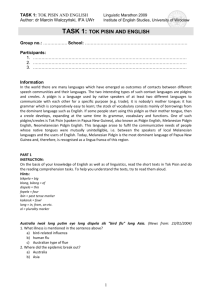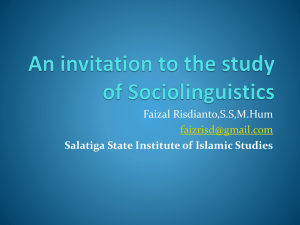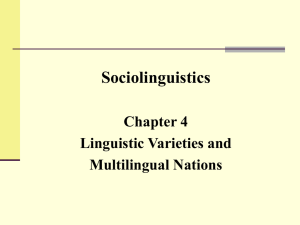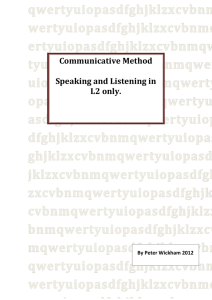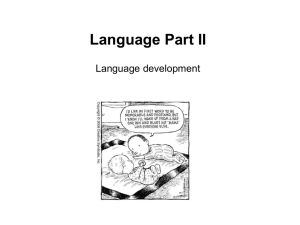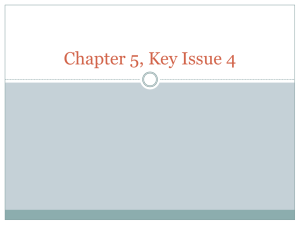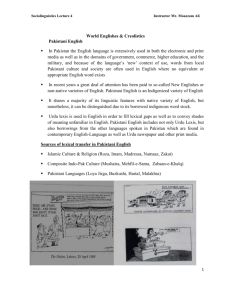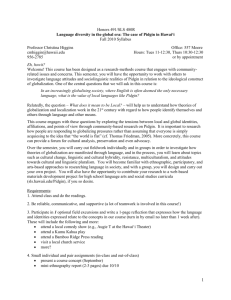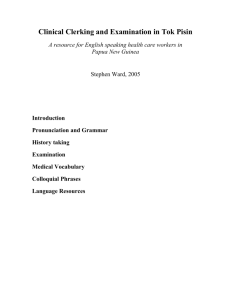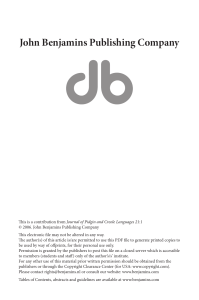Pidgins and creoles - Homepage.ruhr-uni
advertisement
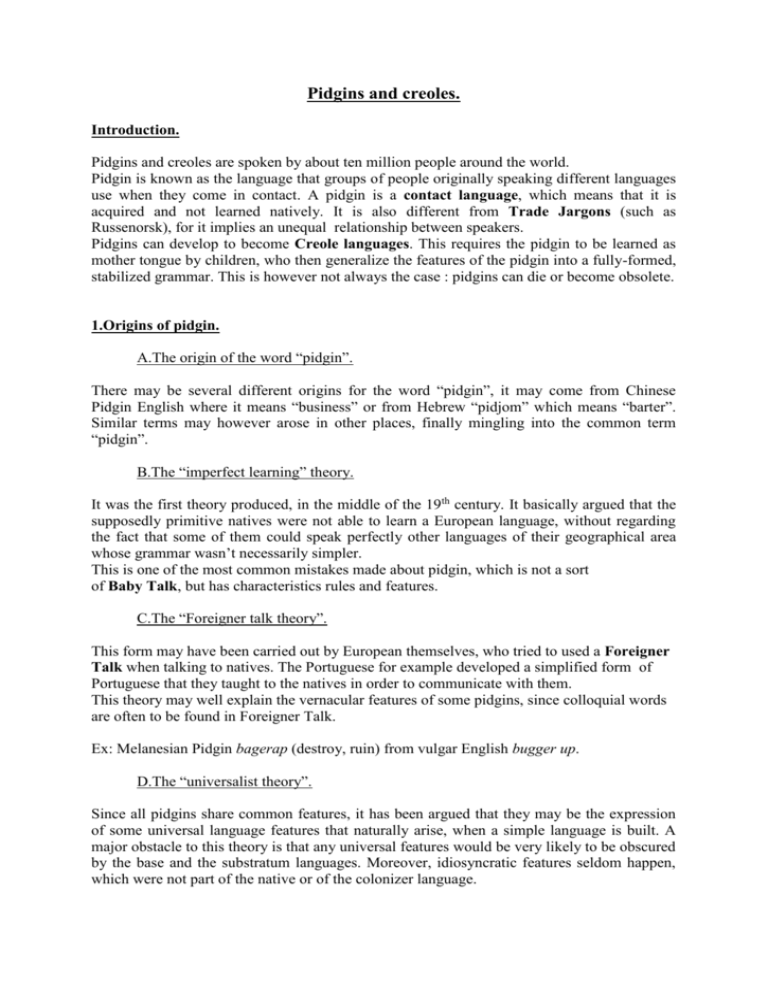
Pidgins and creoles. Introduction. Pidgins and creoles are spoken by about ten million people around the world. Pidgin is known as the language that groups of people originally speaking different languages use when they come in contact. A pidgin is a contact language, which means that it is acquired and not learned natively. It is also different from Trade Jargons (such as Russenorsk), for it implies an unequal relationship between speakers. Pidgins can develop to become Creole languages. This requires the pidgin to be learned as mother tongue by children, who then generalize the features of the pidgin into a fully-formed, stabilized grammar. This is however not always the case : pidgins can die or become obsolete. 1.Origins of pidgin. A.The origin of the word “pidgin”. There may be several different origins for the word “pidgin”, it may come from Chinese Pidgin English where it means “business” or from Hebrew “pidjom” which means “barter”. Similar terms may however arose in other places, finally mingling into the common term “pidgin”. B.The “imperfect learning” theory. It was the first theory produced, in the middle of the 19th century. It basically argued that the supposedly primitive natives were not able to learn a European language, without regarding the fact that some of them could speak perfectly other languages of their geographical area whose grammar wasn’t necessarily simpler. This is one of the most common mistakes made about pidgin, which is not a sort of Baby Talk, but has characteristics rules and features. C.The “Foreigner talk theory”. This form may have been carried out by European themselves, who tried to used a Foreigner Talk when talking to natives. The Portuguese for example developed a simplified form of Portuguese that they taught to the natives in order to communicate with them. This theory may well explain the vernacular features of some pidgins, since colloquial words are often to be found in Foreigner Talk. Ex: Melanesian Pidgin bagerap (destroy, ruin) from vulgar English bugger up. D.The “universalist theory”. Since all pidgins share common features, it has been argued that they may be the expression of some universal language features that naturally arise, when a simple language is built. A major obstacle to this theory is that any universal features would be very likely to be obscured by the base and the substratum languages. Moreover, idiosyncratic features seldom happen, which were not part of the native or of the colonizer language. 2. Structure of pidgin. Since pidgin isn’t a fully fledged language, it has quite an easy structure: there are fewer words, fewer sounds and fewer constructions. It also often has only one form per unit of meaning. But this apparent transparency also brings problems such as ambiguity( due to the limited number of vocabulary items) or length (some basic concept sometimes need to be expressed through a huge amount of words). 3.Creole. Creole come from the French créole (indigenous) that was borrowed from Spanish criollo (native). It is commonly known as a one-time pidgin which has become the mother tongue of a community. The pidgin must of course undergo quite a number of improvement before it can be considered as a viable full language. Some of the changes occur before it is acquired as first language whereas other are initiated by the new native speakers. 4.Decreolization. When a pidgin becomes the native speech of a community, it is depidginized into a Creole. If/when a Creole merges gradually with the standard language it is lexically based on, it becomes decreolized or enters into a Post-Creole Continuum (range of speech varieties which extent from the more or less pure European language to the more or less pure Creole, with all kinds of intermediate varieties), and the boundary between the two becomes gradual, or a continuum. A complete decreolization implies that the grammar of the original create becomes more or less integrated into the grammar of the European language whereas the pure Creole disappears and its vestiges acquires features reminding those of the European language’s dialects. A decreolisation is thus a mere shift from a fully formed language to another. Pidgins and creoles : The example of Tok Pisin. Tok Pisin (tok means "word" or "speech", pisin means "business") is the creole spoken in Papua New Guinea (PNG). It is one of the official languages of PNG and the most widely used language in that country, spoken by about 2 million people as a second language. Tok Pisin was also called Melanesian Pidgin English or Neo-Melanesian. Tok Pisin is used to some extent in the media and for government issues, though English is still preferred in these contexts. In some schools Tok Pisin is the language of instruction in the first three years of elementary education. Its vocabulary is about 5/6 Indo-European and 1/6 Austronesian languages; its grammar is built on a simple pidgin grammar, with various irregularities. The verb has one suffix, -im to indicate transitivity (luk, look; lukim, see). But some verbs, such as kaikai "eat", can be transitive without it. Tense is indicated by the separate words bai (future) and bin (past). The progressive tense is indicated by the word stap - eating is kaikai stap. The noun does not indicate number, though pronouns do. Adjectives usually take the suffix -pela when modifying nouns; an exception is liklik "little". Liklik can also be used as an adverb meaning "slightly", as in dispela bikpela liklik ston, "this slightly big stone". Pronouns show person, number, and exclusiveness/inclusiveness: Singular Dual Trial Plural 1st exclusive mi (I) mitupela mitripela mipela (he/she and I) (both of them, and I) (all of them, and I) 1st inclusive - yumitupela (thou and I) 2nd yu (thou) yutupela (you two) yutripela (you three) yupela (you four or more) 3rd em (he/she) tupela (they two) tripela (they three) ol (they four or more) yumitripela yumipela (both of you, and I) (all of you, and I) Reduplication is very common in Tok Pisin. Sometimes it is used as a method of derivation; sometimes words just have it. Some words are distinguished only by reduplication: sip "ship", sipsip "sheep". There are only two proper prepositions: bilong, which means "of" or "for", and long, which means everything else. Some phrases are used as prepositions, such as long namel (bilong), "in the middle of”. Tok Pisin can sound very colourful in its use of words, which are derived from English (with Australian influences), indigenous Melanesian languages and German (part of the country was under German rule until 1919). However, Tok Pisin is often ridiculed as 'baby talk' or 'broken English'. For example, the word for 'moustache' is mausgras - literally 'mouth grass'. *Tok Pisin has five vowels : [a] [e] [i] [o] [u] Slip (sleep) and sip (ship) rhyme There are also no differences between [p] and [f] *Pidgins have a small lexicon limitated to 1,000 to 2, 000 words, which obliges the speaker to use circumlocution to express certain concepts. (see Reader p.424) papa bilong mi : my father gras bilong het : hair gras pilong pisin : bird feathers pikini bilong diwai : (literally “child of tree”) fruit This can become problematic with concepts such as “hymn”: singsing bilong haus lotu (song of a house worship) *The embedding (combination of two sentences by inserting one into the other) is seldom used. This man smashed up your car. He is my brother.→This man who smashed up your car is my brother. The two statements would only be juxtaposed in a pidgin: Dispela man I bagarapim ka bilong yu, em I brata bilong mi.
